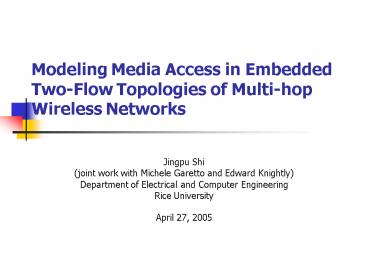Modeling Media Access in Embedded TwoFlow Topologies of Multihop Wireless Networks - PowerPoint PPT Presentation
1 / 25
Title:
Modeling Media Access in Embedded TwoFlow Topologies of Multihop Wireless Networks
Description:
Modeling Media Access in Embedded Two-Flow Topologies of Multi-hop. Wireless Networks ... Media access modeling. Twelve topologies. Identical transmission ... – PowerPoint PPT presentation
Number of Views:50
Avg rating:3.0/5.0
Title: Modeling Media Access in Embedded TwoFlow Topologies of Multihop Wireless Networks
1
Modeling Media Access in Embedded Two-Flow
Topologies of Multi-hopWireless Networks
- Jingpu Shi
- (joint work with Michele Garetto and Edward
Knightly) - Department of Electrical and Computer Engineering
- Rice University
- April 27, 2005
2
Background Introduction Wireless Medium Access
Control
b
A
- In a wireless network, how stations access
channel to accomplish transmissions ? - The MAC (Medium Access Control) is a set of rules
to determine how to access the medium (channel). - Performance Metrics
- Throughput
- Fairness etc.
a
B
(a) Ad Hoc network
(b) Hot Spot
3
Background Introduction Hidden Terminal Problem
b
A
- A simple MAC solution a station starts
transmitting only after it senses the channel is
idle. - Hidden terminal can not be sensed, therefore
packets could collide, and be destroyed.
a
B
(a)
a
b
B
A
(b)
4
Background Introduction IEEE 802.11 MAC
- A distributed algorithm.
- 4-way or 2-way exchange for every data packet
transmission. - 4-way exchange Control packet transmissions
precede data packet transmissions to avoid
collision. - Maintain a value CW (contention window) using a
exponential increase linear decrease algorithm.
5
Background Introduction IEEE 802.11 MAC
(continued)
Sender
RTS
DATA
CTS
ACK
Receiver
Others
RTS
CTS
6
Motivation of This Work
- In Multi-hop wireless networks, scenarios similar
to the hidden terminal problem lead to fairness
problems. - Those problems have not been very well addressed
and understood. - In this work, we view a network as a set of
sub-graphs consisting two flows and characterize
its media access.
Source
Destination
7
Outline
- Background and Motivation
- Scenario identifications and their likelihood to
occur - Fairness simulations
- Media access modeling
8
Twelve topologies
- Identical transmission range and interference
range. - We only consider one-way flows.
- A link is established when two stations are in
radio range.
9
All Possible Topologies
10
Scenario Classification
- Senders Connected (SC) scenarios 2-7, where
senders of each flow are in radio range. - Asymmetric Incomplete State (AIS), scenarios 11
and 12, where senders are disconnected,
asymmetric connections between the two flows. - Symmetric Incomplete State (SIS), scenario 8, 9
and 10, where senders are disconnected, symmetric
connections between the two flows.
11
Scenario LikelihoodAssumptions and illustration
- Whats the probability of each scenario occurring
? - Spatial analysis, assuming the two flows are
uniformly distributed in a region and border
effect is negligible.
12
Scenario LikelihoodResults for each scenario
- Scenario 11 dominates when distance becomes large
13
Scenario LikelihoodResults for each group
AIS and SIS class are highly likely to occur when
distance between two hops becomes large.
14
Outline
- Motivation
- Scenario identifications and their likelihood
- Fairness simulations
- Media access modeling
15
Performance Simulations With CSMA/CA protocol
- Observations
- SC-No fairness problem.
- AIS-Both short-term and long-term fairness
problems. - SIS-Long-term fair, short-term unfair.
- Root cause different information about the
channel.
16
Outline
- Motivation
- Scenario identifications and their likelihood
- Fairness simulations
- Modeling media access
17
Modeling Framework
- Identify 4 different state
- idle channel
- channel occupied by successful transmissions
- channel occupied by a collision
- busy channel due to activity of other stations
- Define probabilities
- Probability of the four stats and throughput of
the station
18
Model AIS ClassSample topology and modeling
strategy
- Use decoupling technique.
- Independently study the behavior of each
transmitting node. - Consider flow B first, and then flow A.
19
Model AIS Class Strategies and steps
- For the first flow, the only unknown parameter is
collision probability, which can be computed from
the plot above. - For the second flow, the only unknown parameter
is b, which can be computed easily given
throughput of flow A is known.
20
Model AIS ClassResults
- With RTS/CTS
Without RTS/CTS
21
Model SIS ClassSample topology and modeling
strategy
- We analyze short-term unfairness.
- Main difficulty the two transmitting nodes are
tightly correlated. - A Markov chain model using bi-dimensional state
description.
22
Model SIS Class Strategies and steps
- We represent the system state as pair (SA, SB),
where SA and SB denote the backoff stage of
Sender A and B respectively. - Transition probability of the Markov chain.
- ri is the probability that a station transmits
after one slot in backoff stage i. f is the
duration of the first packets (RTS or DATA)
transmitted. - After solving the Markov chain, we can compute
the transition time from state (m, 0) to (0,m),
where m is the maximum backoff stage.
23
Model SIS ClassResults (cont.)
(C1) RTS/CTS access, m 6, CWmax 1024. (C2)
RTS/CTS access, m 8, CWmax infinity. (C3)
Basic access, m 3, CWmax 1024. (C4) Basic
access, m 6, CWmax 1024.
24
Outline
- Background and Motivation
- Scenario identifications and their likelihood to
occur - Fairness simulations
- Media access modeling
25
- More Questions or Comments ?
- Email jingpu_at_rice.edu






























